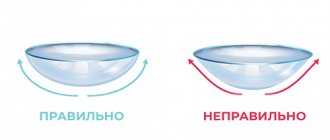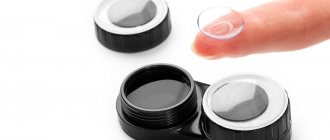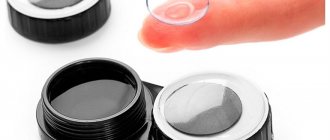The question of how to put on lenses worries every beginner. Please read our instructions carefully: in the article we will go through the procedure step by step and answer the most frequently asked questions.
The first session of putting on and removing contact lenses should be supervised by an ophthalmologist. Before purchasing, you must undergo a vision and eye condition test to determine which diopters are suitable for you and whether there are indications for complex correction lenses. You can get expert advice on optical terms and a free first pair of Bausch&Lomb® contact lenses by obtaining a certificate on our website.
Hand hygiene
Any actions with lenses must be done with absolutely clean hands. Since they are in direct contact with our eyeballs, dirt that gets from our hands onto the lens and then onto the mucous membrane can lead to dangerous inflammatory diseases. Up to five thousand different types of microorganisms can live on our hands, which cause dangerous diseases such as:
- viral infections (ARVI flu, chickenpox, etc.);
- intestinal ailments;
- conjunctivitis, etc.
Imagine that some of them get on the mucous membrane? Eye diseases can cause quite serious consequences, especially with prolonged treatment, including loss of vision. Therefore, do not neglect to observe basic hygiene rules.
Before removing lenses from your eyes, or, conversely, putting them on, wash your hands thoroughly with soap and then dry with a smooth cotton towel. Do not use a fluffy towel for drying - lint from it can remain on your hands and then get onto the lens and into your eyes, thereby causing irritation.
What if the procedure needs to be carried out outside the home environment and it is not always possible to wash your hands? In this case, you need to first stock up on special antibacterial gels, which are sold in small bottles. They can be purchased at any pharmacy or supermarket. The main components of such products are triclosan and alcohol, which kill dangerous bacteria in a matter of seconds. Moisturizing agents and flavorings are also added to the gel to give a pleasant smell. This is a convenient means of ensuring clean hands in any emergency situation. You need to apply a small amount of gel to your palm and rub. Instead of antibacterial gel, you can also use wet wipes.
Differences between manipulations with colored, scleral and astigmatic lenses
Colored ones are put on in the same way as regular SCLs, that is, you can use the algorithm presented above.
Scleral ones are larger, and to place them on the eye it is worth holding them with three fingers rather than one. They are first filled with sterile saline or a special liquid.
Astigmatic, also known as toric, have fixation features depending on their type.
Learning to quickly put on and remove contact lenses from your eyes is not a problem. Although at first it seems that this is impossible, gradually the whole process will proceed automatically, the user will not even have to think about the procedure.
Tweezers and suction sticks for easy lens removal
Manufacturers of optics also make sure that users are not only comfortable to wear, but also to care for. So, they produce special suction cups to remove contact lenses. These are small sticks with a silicone tip that literally “sucks” to the surface of the lens. The use of such an accessory allows you to avoid direct contact with the eyes and significantly increases the hygiene of the removal and donning procedure.
It would also be useful to purchase tweezers, which are designed to remove contact correction products from the solution in the container and vice versa. Tweezers are either plastic or silicone, or plastic with silicone tips. All listed accessories can be found in the magazinlinz.ru catalog.
They are sold individually or in travel kits. How to remove lenses with a suction cup or put them on, you can watch the video or ask an ophthalmologist to show the sequence of the procedure.
Does it hurt to put on lenses?
There shouldn't be any pain. Out of habit, you may experience slight discomfort, which quickly passes.
Unpleasant sensations sometimes occur when using rigid vision correctors, which are designed to correct defects in the lens or cornea. There is no discomfort when wearing soft contact lenses made of silicone hydrogel and hydrogel.
As a rule, during the consultation, the ophthalmologist will tell you how to properly put on contact lenses.
How to remove lenses with long nails?
Many women prefer long nails with a beautiful manicure. Of course, this makes hands attractive, but long nails create an additional problem and danger when handling optics. Soft contact lenses often break due to damage from long nails. In addition, they can easily scratch the mucous membrane if moved carelessly.
What to do in such a situation when you want to maintain a beautiful manicure and increase the safety of removing contact optics? In this case, experts recommend using a suction stick and tweezers. Their use will eliminate direct contact with the lenses, ensuring the safety of the material. Another option is to wear one-day contact models. In this case, the likelihood of damage will be significantly reduced, since the pair is used only once. In addition, if the lens breaks, you can immediately replace it with a new one.
Is it possible not to take it off at night?
For the manufacture of modern optics, silicone hydrogel and hydrogel materials are used. They freely pass oxygen to the cornea, allowing it to receive useful microelements and nutrients. Therefore, even correctors forgotten for one night will not harm the health of the visual organs.
However, you shouldn't get carried away with this. During sleep, protein deposits accumulate on the surface of the correctors. Because of this, the optics restore visual acuity worse, the picture becomes blurry and cloudy. Correctors can only be continued to be used after preliminary cleaning and disinfection.
How to properly remove contact lenses from your eyes
Most contact correction products have a daily wear schedule. This means that they need to be removed every night before going to bed and carried out hygiene procedures, and then placed in a container with a universal disinfection solution for several hours. How to do everything without risk to the eyes? This is not difficult if you carry out the process carefully and consistently.
- Wash your hands and dry them. Prepare, if necessary, a lens suction cup, as well as tweezers, a container, and a bottle of solution.
- You should always start with one eye, for example, the left one. This will make it easier for you to get used to the algorithm and not mix up the lenses.
- Direct your gaze upward. Hold the eyelid with the finger of one hand, and with the middle finger of the hand with which you will remove the lenses, pull down the lower eyelid.
- Gently pinch the lens between the pads of your index finger and thumb to remove it from your eye. Try to do this gently, without pressing too hard. If necessary, you can remove it with a suction cup.
- Place the removed lens on your palm - now you can carry out caring procedures. After they are finished, repeat the same steps with the second lens.
Use of corneal models
How to properly put on lenses whose size does not exceed 10 mm? They are designed to be fixed to the cornea and have a more rigid design than conventional lenses. Corneal models are used to correct astigmatism, keratoconus, and age-related farsightedness. Often used for night vision correction.
How to wear eye lenses correctly? The process is practically no different from putting on soft models. The only difference is that they need to be placed just below the pupil, and then cover the eyelid.
When positioned correctly, the optics do not create the sensation of the presence of a foreign body. If discomfort occurs, you need to pull out the product and fix it again.
How to carry out hygiene procedures after removing optics
Improper handling and careless attitude towards disinfection of contact optics is the main cause of the development of inflammatory ophthalmological diseases. All models with a service life longer than daily require regular care. Only by observing all the requirements for wearing contact lenses can you ensure eye safety.
So what should you do after the lens is removed? Holding it in the palm of your hand, pour a little all-purpose solution on top and then rub gently between your index finger and thumb for 15-20 seconds. After such mechanical cleaning, you need to place the contact lens in the container (using tweezers for this), fill it with fresh solution and screw on the lid.
Then remove the second lens and repeat the cleaning procedure. With timely and proper care of contact optics, they will not cause harm to the eyes.
What happens if you put your lenses on inside out?
Don't be alarmed, nothing bad will happen. A lens put on inside out will cause discomfort, will not fit into place and will be very mobile compared to a lens put on correctly. Carefully remove the lens, rinse it in multi-use solution and try again. Another case is when the lens gets stuck under the eyelid. To remove it, relax your eyelid, try to determine by feel or touch where it is. Pull back the eyelid, make sure that the lens is there - and with massaging movements move it to the center or to the corner of the eye - where it will be easier to reach. If you cannot remove the lens yourself, consult a doctor for help.
How to remove lenses from eyes for beginners?
This moment is one of the most difficult for users who have just started wearing contact correction products. Many people are afraid of damaging the lens or even touching it in the eye. What can you do to cope with these moments?
Ophthalmologists recommend that beginners use suction sticks at first so as not to touch the lens directly. This will be especially convenient to do with hard lenses, which are not always convenient to grip with your fingers. In addition, to better remember the procedure for removing and putting on, use a mirror - this way you can learn how to do it faster. Once the skill has already been mastered, it will not be needed.
Before putting on lenses, you can use special eye drops to moisturize. This is especially true for users with excessive dry eyes, as well as for those who wear harsh contact correction products. 1-2 drops will help lubricate the mucous membrane and make putting it on easier.
Symptoms of a stuck lens
If the eye optics are installed correctly, they will not cause any discomfort. If it moves to the side, there will be a feeling of the presence of a foreign object in the eye.
If it ends up under the eyelid, the following unpleasant symptoms may appear:
- pain;
- fear of light;
- burning;
- lacrimation;
- deterioration of visual acuity when the contact means is shifted with diopters.
Since misaligned contact products interfere with the normal sliding of the eyelids, closing and opening them will be very difficult.
Tips for using colored lenses:
Never sleep with your colored contact lenses on and always take them out before going to bed. If lenses are left in your eyes overnight , you may get an eye infection. If you still have trouble getting your lenses in or out, contact your eye doctor. He will show you how to properly insert and remove them, as well as give you tips on how to properly care for your colored contact lenses .
The information on our website is provided for informational purposes only and should not be used as an experiment without the advice of an ophthalmologist or other medical expert. We do not accept any responsibility for your actions taken without the approval of your ophthalmologist.
Possible complications
If removed untimely, the cornea will become red and inflamed, which will cause infection. In addition to irritating the mucous membrane, stuck contact optics will not deprive you of vision or cause dangerous harm. If the lenses are poorly cleaned, an inflammatory process and sticking to the cornea will occur. Harsh products can scratch the cornea, causing microdamage.
It is very rare for lenses to become stuck in the eye, so this is not a cause for concern. If there is constant displacement, it is advisable to consult an ophthalmologist. Sticking of the product can be eliminated by choosing a different model. At the same time, it will be very convenient to get it out both with your hands and with special devices.
It is not recommended to wear other people's lenses. If the size does not match, they will often shift, which can impair vision. This applies more to color models, in which only a transparent central area is allocated for the pupil, allowing light to pass through.











